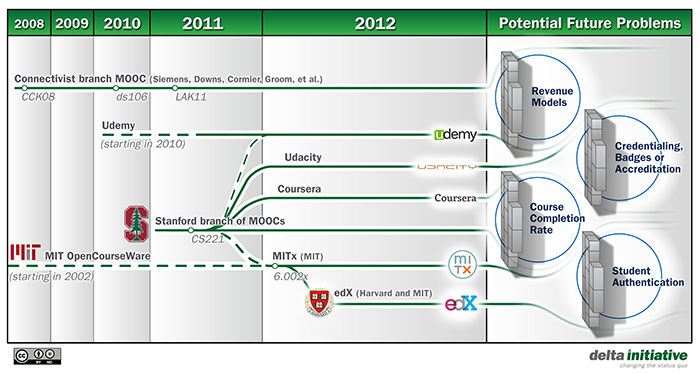What are MOOCs?
MOOCs are massive open online courses. Each of the terms massive, open and online have some degree of flexibility in meaning, which has resulted in difficulty pinning down an exact definition for what constitutes a MOOC, beyond being an online course that is open in some capacity to any learner worldwide.
Open online courses have been offered for many years (e.g., through open universities, MIT OpenCourseWare, iTunes U, etc...), but the term MOOC didn't come into existence until 2008, when David Cormier from the University of Prince Edward Island, coined it in reference to a course called "Connectivism and Connected Knowledge" that was being offered by George Siemens and Stephen Downes at the University of Manitoba. This MOOC, and many of the early MOOCs that followed, focused on collaborative learning, connectivism, open educational resources, remix culture, emergent curriculum, decentralized resources and were highly dependent on social media and collaborative online environments. Soon, other institutions began offering their own MOOCs.
MOOCs underwent a significant shift in 2011 when Stanford University launched three MOOCs from instructors Sebastian Thrun, Peter Norvig, Andrew Ng and Jennifer Widom. Like previous MOOCs, these Stanford MOOCs were open to the general population and used techniques such as online discussion and peer-marked assignments, but unlike earlier MOOCs, they relied heavily on video lectures and multiple choice assessments. Throughout 2012, many institutions began offering similar MOOCs and soon, MOOC providers like Udacity, Coursera and MITx began popping up. This shift in MOOCs led practitioners to start differentiating between the two types of MOOCs: cMOOCs - or connectivist MOOCs - for the earlier style MOOCs, and xMOOCs - or extended MOOCs - for the Standford-style MOOCs.
MOOC Challenges
In recent years, the popularity of MOOCs has exploded, but despite their popularity, MOOCs are currently one of the most controversial ideas in post-secondary education because of the many challenges they present. In 2012, Phil Hill from the Delta Initiative clearly illustrated the four main problems that MOOC providers were encountering:

http://i1.wp.com/mfeldstein.com/wp-content/uploads/2012/07/EvolutionCombine20120815.jpg
(source: http://mfeldstein.com/four-barriers-that-moocs-must-overcome-to-become-sustainable-model/)
Critics often point to other problems that plague MOOCs, including high production costs and low levels of instructor interaction and feedback. Because of these challenges, some institutions have rejected MOOCs completely, while some others have adopted a "wait-and-see" attitude towards them.
MOOC Benefits
Yet despite these challenges, many institutions have also embraced MOOCs and the promise they hold for post-secondary institutions. Some of these institutions use existing MOOCs within their courses, some create their own MOOCs and some do a combination of both. Supporters cite a long list of potential benefits for MOOCs, including:
- Improving access to learning
- Improving knowledge sharing
- Building the university's brand
- Building academics' brand
- Extending the reach of the institution
- Creating high quality educational resources
- Providing content for blended/flipped courses
- Improving the pedagogy of existing courses
- Personalizing learning through learning analytics
- Providing accessible professional development for alumni
- Generating revenue through for-credit offerings
- Being at the forefront of innovative practice
Unfortunately, research on the effectiveness of MOOCs is just emerging, but the early research is promising and providing many valuable recommendations and best practices.
Why MOOCs at the University of Alberta?
Building a global university for the public good, the University of Alberta develops massive open online courses that:
- contribute to our historical goal of "uplifting the whole people",
- showcase the university by sharing its teaching and research expertise,
- differentiate the University of Alberta from other institutions,
- integrate technology to support and enhance high-quality educational experiences for students, and,
- respond to changes in the learning environment by providing students flexibility while maintaining high-quality for-credit offerings.
Will MOOCs play a significant role in the future of post-secondary education? Only time will tell; however, the many potential benefits of both creating and using MOOCs make them something worth exploring further.
MOOC Resources
- 7 Things You Should Know About MOOCs (Educause, 2013)
- What Campus Leaders Need to Know about MOOCs (Educause, 2012)
- Video: MOOCs and Beyond (Educause, 2013)
- TED Playlist: MOOCs 101
MOOC Research
- MOOC Research Initiative (Bill and Melinda Gates Foundation)
- Distance Education Special Issue - MOOCs: Emerging Research (July, 2014)
- International Journal for Innovation and Quality in Learning Special Issue - Quality in MOOCs (September, 2014)
- Journal of Global Literacies, Technologies, and Emerging Pedagogies Special Issue on MOOCs (July, 2014)
References
American Council on Education & Inside Track. (2013). To MOOC or Not to MOOC: Strategic Lessons from Pioneers.
Retrieved from: http://www.acenet.edu/news-room/Pages/To-MOOC-or-not-to-MOOC-Strategic-Lessons-from-the-Pioneers.aspx
Hollands, F. & Tirthali, D. (2014). MOOCs: Expectations and Reality.
Retrieved from: http://www.academicpartnerships.com/sites/default/files/MOOCs_Expectations_and_Reality.pdf